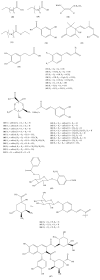Research Progress on Chemical Constituents of Lonicerae japonicae flos
- PMID: 27403439
- PMCID: PMC4923575
- DOI: 10.1155/2016/8968940
Research Progress on Chemical Constituents of Lonicerae japonicae flos
Abstract
Lonicerae japonicae flos is commonly used in traditional Chinese medicine for thousands of years with confirmed curative effects. Except for medicine, it is also used in healthy food, cosmetics, and soft beverages for its specific activities. Therefore, the chemical constituents, mainly including organic acids, flavonoids, iridoids, triterpenoids, and volatile oils, have been well studied by many scholars in recent years and a comprehensive and systematic review on chemical constituents of Lonicerae japonicae flos is indispensable. This paper aims at reviewing the chemical components of LJF in recent years through searching for the literatures both at home and abroad. Our results show that 212 components have been isolated from Lonicerae japonicae flos, including 27 flavonoids, 40 organic acids, 83 iridoids, 17 triterpenoids, and 45 other compounds, which could lay a foundation for the further application of Lonicerae japonicae flos.
Figures
References
-
- Liu Y., Wang G. L. Effect of Flos Lonicerae extracts on herpes simplex keratitis. Herald of Medicine. 2011;30(11):1421–1424. doi: 10.3870/yydb.2011.11.006. - DOI
-
- Ning W., Peng X., Ma L., et al. Enhanced secondary metabolites production and antioxidant activity in postharvest Lonicera japonica Thunb. in response to UV radiation. Innovative Food Science and Emerging Technologies. 2012;13:231–243. doi: 10.1016/j.ifset.2011.10.005. - DOI
Publication types
MeSH terms
LinkOut - more resources
Full Text Sources
Other Literature Sources
Medical







